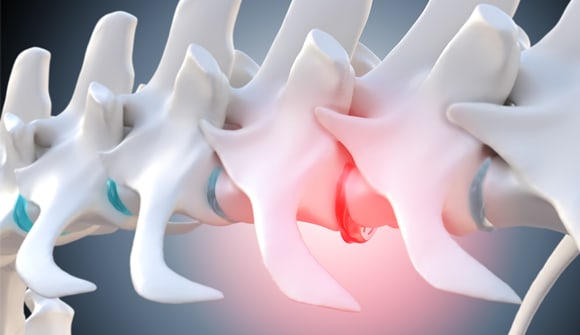Defining disks
Spine surgeon explains the differences in conditions, causes and treatments of back pain.
Article Author: Juliette Allen
Article Date:

Chances are, you don’t realize how often you bend, twist or reach each day. Unless, that is, your back hurts with each movement.
Back pain is one of the leading causes of Emergency Room visits. One of the terms frequently used when describing and diagnosing a back injury is a “disk.”
“A disk is like a shock absorber that sits between the bones of the spine [vertebrae],” explained Ashutosh Pradhan, MD, a neurosurgeon with Lyerly Neurosurgery at Baptist Health. “People can think of it like a washer in a toolset, which is used to stabilize and evenly distribute the load. There's an outside part made of rubber bands and an inside part made of jelly.”
Types of spinal disk injuries
According to Dr. Pradhan, disk injuries typically fall into three categories:
1. Herniated disk:
Occurs when the disk’s exterior cracks and the jelly-like interior leaks out. The injury typically happens suddenly following a twisting motion or heavy lifting.
2. Slipped disk:
The abnormal movement of the bones above and below the disk, causing misalignment of the spine (spondylolisthesis).
3. Bulging disk:
The natural degeneration of disks that occurs as people age. This condition is common among middle-aged and older adults, and most people won’t experience pain from it.
The severity of symptoms someone experiences depends on whether the disk is pushing on a nerve. If it is, a person will often experience pain or weakness down his or her leg. If it’s not, someone may have low back pain.
Dr. Pradhan cautioned that anyone experiencing bowel or urinary incontinence should talk to their doctor immediately.
Back pain relief: treating a troubled disk
According to Dr. Pradhan, treatment for disk injuries generally starts conservatively with physical therapy and potentially epidural (steroid and numbing medication) injections to help alleviate pain. He added that patients sometimes find relief in acupuncture, yoga or Pilates. Pain from herniated disks will typically go away on its own as the body reabsorbs the jelly-like fluid that had leaked.
If someone’s still experiencing pain after six to 12 weeks of these conservative approaches, he or she may be a candidate for spine surgery. Possible procedures include:
1. Spinal fusion:
The creation of bone-like material between the vertebrae to stabilize the spine and eliminate abnormal motion that may cause pain.
2. Disk replacement:
The insertion of an artificial disk into the spine to maintain normal range of motion.
3. Diskectomy:
Removal of a piece of disk that’s in an abnormal place.
“Patients who undergo an upper-neck procedure can often go home the same day,” said Dr. Pradhan. “Those who have had lower-back surgery may require a night in the hospital. I usually recommend six weeks of recovery time with just light activity, like walking, before they can ease into playing a sport or going to the gym.”
Pain-free future
Though the thought of spine surgery can be daunting, Dr. Pradhan urged people who are experiencing back pain to not delay getting evaluated by an expert.
“Just because you meet with a surgeon doesn’t mean you’re going to need surgery,” he said. “You don’t have to live in pain. Even if an MRI doesn’t show a clear injury, our team will work with you to figure out what’s causing your discomfort and determine the best course of treatment to restore your quality of life.”
Don’t let back pain get in your way.
Get back to what you love. To learn more about surgical and nonsurgical treatments for back pain, call 904.202.BACK (2225) or visit baptistjax.com/back.



